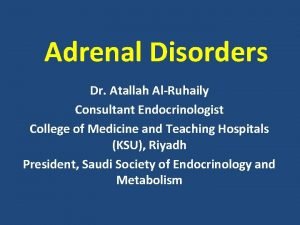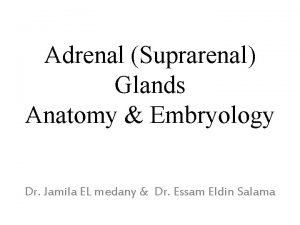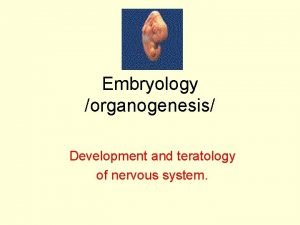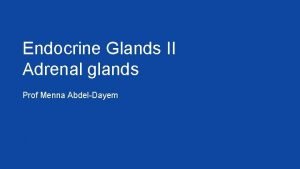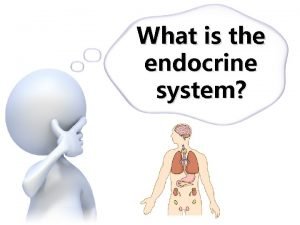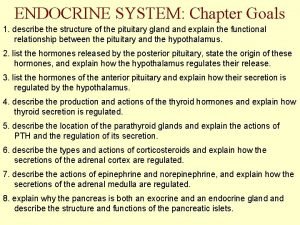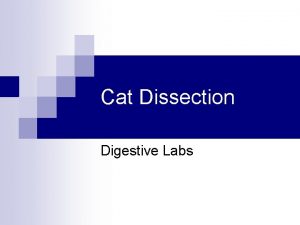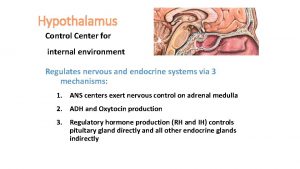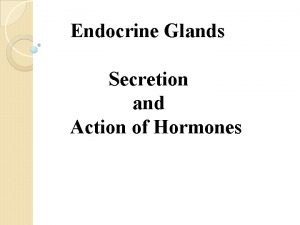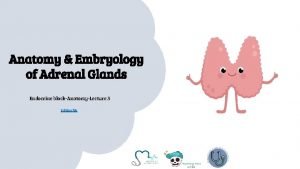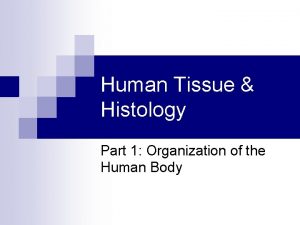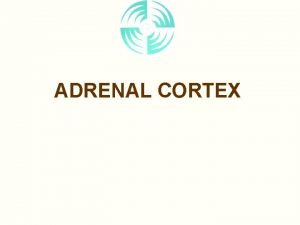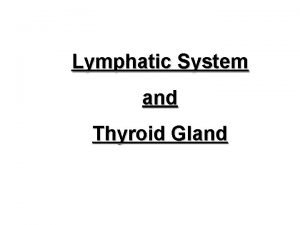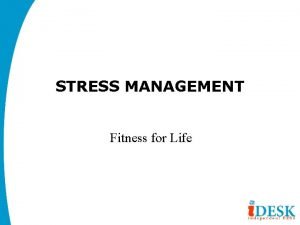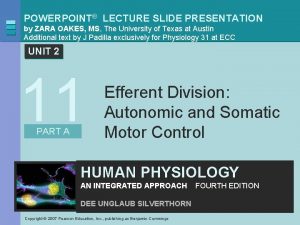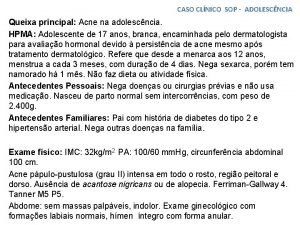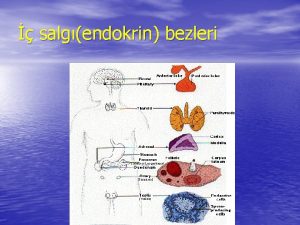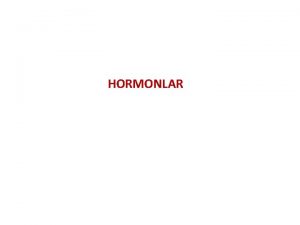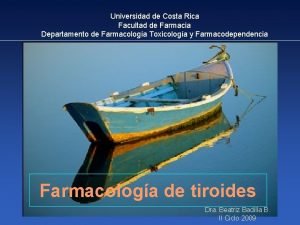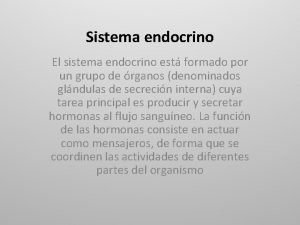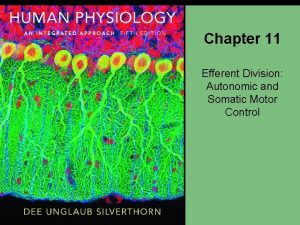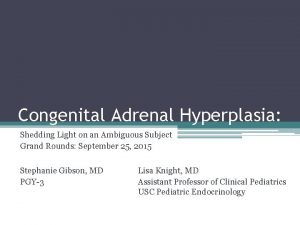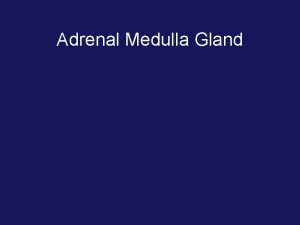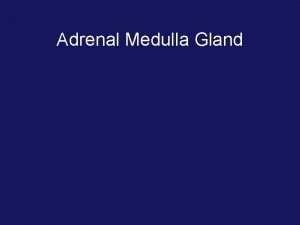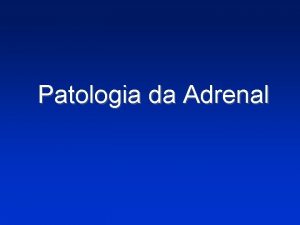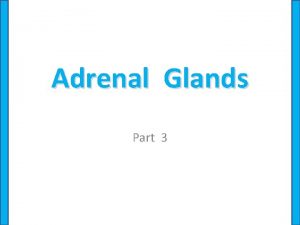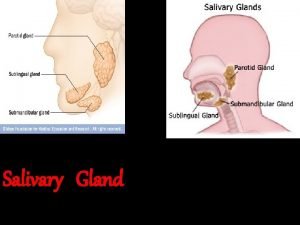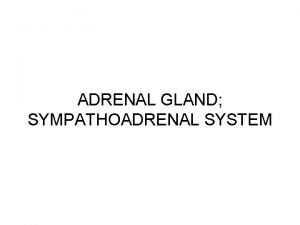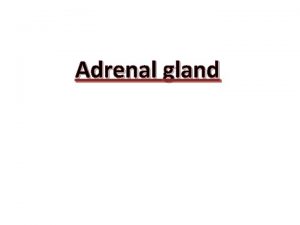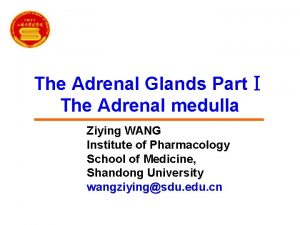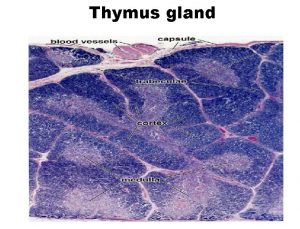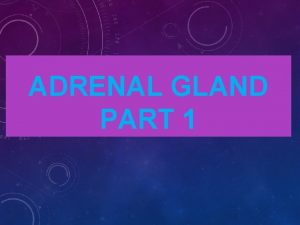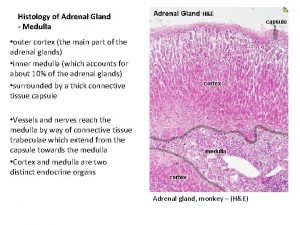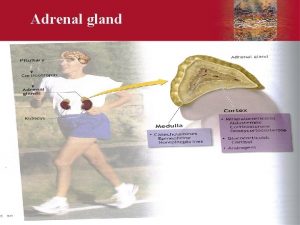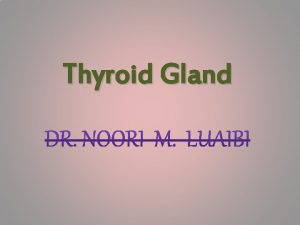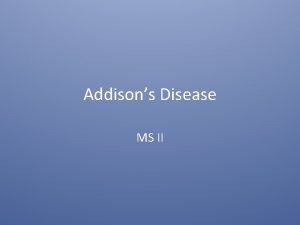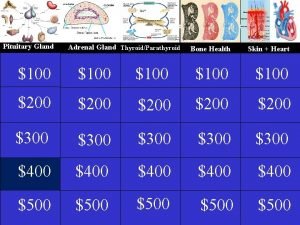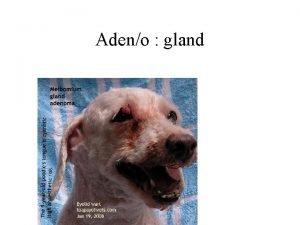Adrenal Gland Part 3 Adrenal medulla Adrenal medulla








































- Slides: 40

Adrenal Gland (Part 3)

Adrenal medulla: Adrenal medulla structure and function of medullary hormones: 1. Catecholamines: Most of the catecholamine output in the adrenal vein is epinephrine. Norepinephrine enters the circulation from noradrenergic nerve endings The plasma norepinephrine level is generally unchanged after adrenalectomy, but the free epinephrine level, falls to essentially zero. The epinephrine found in tissues other than the adrenal medulla and the brain is for the most part absorbed from the bloodstream rather than synthesized in situ.

Interestingly, low levels of epinephrine reappear in the blood sometime after bilateral adrenalectomy, and these levels are regulated like those secreted by the adrenal medulla. They may come from cells such as the intrinsic cardiac adrenergic (ICA) cells (Intrinsic cardiac adrenergic (ICA) cells are present in mammalian hearts (atria more than ventricle) and contain catecholaminesynthesizing enzymes sufficient to produce biologically active norepinephrine levels), but their exact source is unknown. The catecholamines have a half-life of about 2 min in the circulation. For the most part, they are methoxylated and then oxidized to 3 -methoxy-4 -hydroxymandelic acid (vanillylmandelic acid [VMA].

2. Chromogranin A: Chromogranin A is major soluble protein of chromaffin granules. In the medulla, norepinephrine and epinephrine are synthesized by adrenal medulla secretory cell (chromaffin cell or post-ganglionic cell) and stored in chromaffin granules along with ATP, chromogranin A Chromogranin A released from the adrenal medulla together with catecholamines upon stimulation of the splanchnic nerve, and also present in various neuro-endocrinal tissues. Chromogranin A widely used tumor marker ( Pheochromocytoma and neuro-endocrinal such as carcinoid tumor and neuroblastoma). 3. Adrenomedullin was initially isolated from a pheochromocytoma, a tumor of the adrenal medulla Adrenomedullin is a 52 amino acid peptide present in adrenal medulla and in other tissues, heart, kidney, intestine. Adrenomedullin is structurally similar to CGRP (calcitonin-gene related peptide) 27% homologue. Adrenomedullin was has vasodilator and natriuretic effects.

Effects of epinephrine and nor-epinephrine: Catecholamines (norepinephrine and epinephrine) mimicking ﻳﺸﺎﺑﻪ the effects of noradrenergic nervous discharge. These hor mones potentiate and sustain the effects of sympathetic stimulation Catecholamines exert metabolic effects that include a. mobilization of free fatty acids (FFA), b. increased plasma lactate, c. stimulation of the metabolic rate. Catecholamines effects on CVS system a. norepinephrine and epinephrine increase the force and rate of contraction of the isolated heart. These responses are mediated by β 1 receptors. b. norepinephrine and epinephrine increase myocardial excitability,

c. Norepinephrine produces vasoconstriction in most if not all organs via α 1 receptors, epinephrine dilates the blood vessels in skeletal muscle and the liver via β 2 receptors. This usually overbalances the vasoconstriction produced by epinephrine elsewhere, and the total peripheral resistance drops. d. When norepinephrine is infused slowly in normal animals or humans, the systolic and diastolic blood pressures rise. The hypertension stimulates the carotid and aortic baroreceptors, producing reflex bradycardia that overrides the direct cardioacceleratory effect of norepinephrine. Consequently, cardiac output per minute falls. f. Epinephrine causes a widening of the pulse pressure, but because baroreceptor stimulation is insufficient to obscure the

Most adrenal medullary tumors (pheochromocytomas) secrete norepinephrine, or both, and produce sustained hypertension. However, 15% of epinephrine-secreting tumors secrete this catecholamine episodically, producing intermittent bouts of palpitations, headache, glycosuria, and extreme systolic hypertension. These same symptoms are produced by intravenous injection of a large dose of epinephrine Catecholamines increase alertness. Epinephrine and norepinephrine are equally potent in

The catecholamines have several different actions that affect blood glucose. a. Epinephrine and norepinephrine both cause glycogenolysis. Epinephrine and norepinephrine produce effect via β -adrenergic receptors α -adrenergic receptors ↑ (c. AMP) ↑ intracellular Ca 2+ activation of phosphorylase, b. Epinephrine and norepinephrine ↑ insulin +glucagon via β -adrenergic mechanisms

c. Epinephrine and norepinephrine produce a prompt rise in the metabolic rate that is independent of the liver The initial rise in metabolic rate may be due i. to cutaneous vasoconstriction decreases heat loss leads to a rise in body temperature, or ii. increased muscular activity, or both. a smaller, delayed rise that is abolished by hepatectomy and coincides ﺑﻨﻔﺲ ﺍﻻﻥ with the rise in blood lactate concentration. The second rise is probably due to oxidation of lactate in the liver. When injected, epinephrine and norepinephrine cause an initial rise in plasma K + because of release of K + from the liver then a prolonged fall in plasma K + because of an increased entry

Effects of dopamine: Half the plasma dopamine comes from the adrenal medulla, whereas the remaining half presumably comes from the sympathetic ganglia or other components of the autonomic nervous system. The physiologic function of the dopamine in the circulation is unknown. Injected dopamine produces a. renal and mesentery artery vasodilation and vasoconstriction in other arteries, probably by releasing norepinephrine b. positively inotropic effect on the heart by an action on β 1 adrenergic receptors. c. The net effect of moderate doses of dopamine is an increase in systolic pressure no change in diastolic pressure. Because of these actions, dopamine is useful in the treatment of traumatic and cardiogenic shock.

Adrenal Cortex The adrenal cortex three distinct layers: 1. The zona glomerulosa, secreting significant amounts of aldosterone 2. The zona fasciculata secretes the glucocorticoids (cortisol and corti costerone) as well as small amounts of adrenal androgens and estrogens. 3. The zona reticularis secretes the adrenal androgens, small amounts of estrogens and some glucocorticoids.

Factors such as angiotensin II that specifically increase the output of aldosterone and cause hypertrophy of the zona glomerulosa have no effect on the other two zones. Similarly, factors such as ACTH that increase secretion of cortisol and adrenal androgens and cause hypertrophy of the zona fasciculata and zona reticularis have little effect on the zona glomerulosa. All human steroid hormones, including those produced by the adrenal cortex , are synthesized from cholesterol provided by low-density lipoprotein (LDL) in the circulating plasma. Adrenocortical hormones are bound to plasma proteins. Approximately 90 to 95 percent of the cortisol in the plasma binds to plasma proteins, especially a globulin called cortisol-binding globulin or transcortin and, to a lesser extent, to albumin. This high degree of binding to plasma proteins slows the elimination of cortisol from the plasma; therefore, cortisol has a relatively long half-life of 60 to 90 minutes. Only about 60 percent of circulating aldosterone combines with the

Mineralocorticoid: In humans, aldosterone exerts nearly 90 percent of the mineralocorticoid activity of the adre nocortical secretions, but cortisol, the major glucocorti coid secreted by the adrenal cortex, also provides a significant amount of mineralocorticoid activity. The min eralocorticoid activity of aldosterone is about 3000 times greater than that of cortisol, The intense glucocorticoid activity of the synthetic hormone dexamethasone, which has almost zero mineralocorticoid activity, makes it an especially important drug for stimulating specific glucocorticoid activity.

Functions of aldosterone: 1. Aldosterone reabsorb Na+ and H 2 O and secrete K+ especially in the principal cells of the collecting tubules and, to a lesser extent, in the distal tubules and collecting ducts. Aldosterone binds the mineralocorticoid receptor (MR) inside the cell. MR are found in high concentration in A. Epithelial sites: renal collecting duct (Principle cell) colon ducts of sweat and salivary glands B. Non-epithelial sites: heart, brain, vascular smooth muscle, liver peripheral blood leukocytes.

• Aldosterone (A) binds the mineralocorticoid receptor (MR) or aldosterone receptor or nuclear receptor subfamily 3 inside the cell forming MR-A complex MR-A Complex join DNA forming aldosterone-induced protein (AIP) AIP will have the following effects: A. Affects mitochondria to increase energy production B. Open epithelium Na channels (ENa. C) ▼ increase Na inside the cell ▼ Na pushed out by Na-K ATPase (the energy supply will be form mitochondria) C. Na-K ATPase will increase K concentration ▼ K will be secretion to urine by opening K antagonis channels-ROMK. The renal outer medullary potassium channel (ROMK) is an ATP-dependent potassium channel that transports potassium out of cells.

Epithelium Na channels (ENa. C) or amiloride-sensitive epithelial sodium channel (ENa. C) is the major determinant of renal sodium reabsorption. About 45 minutes is required before the rate of sodium transport begins to increase; the effect reaches maximum only after several hours. Epithelium Na channels availability in open conformation at the apical membrane of the cell is increased by: aldosterone vasopressin, glucocorticoids, and insulin. Down-regulate by elevated intracellular levels of: calcium and sodium About 2% of overall Na + re-absorption are affected by aldosterone When sodium is reabsorbed by the tubules, simultaneous osmotic

Excess Mineralocorticoid Hyperaldosteronism associated with Hypokalemia, hypertension, hypernatremia, metabolic alkalosis A. Hypokalemia ► severe muscle weakness often develops. This muscle weakness is caused by alteration of the electrical excitability of the nerve and muscle fiber membranes, which prevents transmission of normal action potentials. B. Severe renal sodium chloride and water retention ►hypertension Aldosterone escape means the escape of the kidney from salt and water retention effect of Hyperaldosteronism effects (Hypokalemia, Na and water retention and hypertension) will continue only for few days and after that these effects will stop and water and Na levels return to normal. Aldosterone escape is a protective mechanism during abnormal elevation of aldosterone or Na retention The term "aldosterone escape" has been used to refer to 2 distinct phenomena that are exactly opposite each other: (1) Primary hyperaldosteronism or Conn's syndrome Possible Aldosterone escape explanation caused by Primary hyperaldosteronism Hyperaldosteronism ► Na and water retention ►increase blood pressure ► a. Pressure natriuresis (increase Na secretion)

(2) Secondary (or Refractory) hyperaldosteronism The inability of angiotensin-converting enzyme (ACE) inhibitor therapy to reliably suppress aldosterone release The possible explanation Secondary (or Refractory) hyperaldosteronism a. Aldosterone is produced by tissues other than adrenal cortex (as heart and blood vessels) b. Aldosterone is produced by a system other than Renin. Angiotensin-aldosterone system c. ACE inhibitor ►suppress aldosterone secretion ►hyperkalemia ►stimulate aldosterone secretion Possible Aldosterone escape explanation caused by Secondary hyperaldosteronism ► Na and water retention ►ANP release ► natriuresis + diuresis Secondary hyperaldosteronism ► Na retention ►increase plasma osmolarity i. Increase thirst ►water intake ►decrease plasma osmolarity ii. Increase vasopressin ►water retention ►decrease plasma osmolarity This why it is preferred to use aldosterone antagonist to avoid aldosterone

2. Excess aldosterone increases tubular hydrogen ion secretion and causes alkalosis. Aldosterone causes secretion of hydrogen ions in exchange for potassium in the interca lated cells of the cortical collecting tubules. This decreases the hydrogen ion concentration in the extracellular fluid, causing metabolic alkalosis. 3. Effect of aldosterone on sweat and salivary glands and intestinal epithelial cells: A. Sweat and salivary glands: The sweat and salivary gland secretions which contains same quantity of Na and Cl as plasma passes the duct. In the duct Na and Cl will be absorb and K and HCO 3 will be secreted. This processes will be enhanced by aldosterone. Causing a decrease of Na and Cl secretion by these glands. B. Colon epithelium: Aldosterone stimulate Na reabsorption which means enhance water reabsorption (osmotic gradient), and Cl reabsorption (electrical gradient).

Regulation of aldosterone secretion: Regulation of aldosterone secretion by the zona glo merulosa cells is almost entirely independent of regula tion of cortisol androgens by the zona fasciculata and zona reticularis. The following four factors are known to play essential roles in regulation of aldosterone: 1. Increased potassium ion concentration in the extracellular fluid greatly increases aldosterone secretion. However, the plasma K level need increase only 1 meq/L to stimulate Aldosterone secretion, and transient increase of this magnitude may occur after a meal, particularly if it is rich in K. 2. Increased angiotensin II concentration in the extracellular fluid also greatly increases aldosterone secretion The factors affecting the secretion of aldosterone through angiotensin: i) A drop in ECF volume or intra-arterial volume decrease renal arterial pressure. reflex increase in renal nerve discharge renin + angiotensin II the rate of secretion of aldosterone. Na water retention, expanding ECF volume shutting off the stimulus

ii) Hemorrhage: Hemorrhage stimulates ACTH and renin secretion. iii) Standing and constriction of the thoracic inferior vena cava: Those two conditions associate with a decrease in intra-arterial volume. iv) Dietary sodium restriction: Dietary sodium restriction causes: First: reflex increases in the activity of the renal nerves. Second: a. up-regulation of the angiotensin II receptors in the adrenal cortex and hence increase the response to angiotensin II b. down-regulates the angiotensin receptors in the blood vessels. 3. Increased sodium ion concentration in the extracellular fluid very slightly decreases aldosterone secretion. An acute decline in plasma Na about 20 meq/L

4. ACTH from the anterior pituitary gland is neces sary for aldosterone secretion but has little effect in controlling the rate of secretion in most physiologi cal conditions. ACTH appears to play a “permissive” role in regulation of aldosterone Of these factors, potassium ion concentration and the reninangiotensin system are by far the most potent in regulating aldosterone secretion. 5. Effect of other factors: Aldosterone secretion increase in the individuals carrying on activities in the upright position due to a decrease in the rate of the removal of aldosterone from the circulation by the liver. Atrial natriuretic peptide (ANP) a. renin secretion b. the responsiveness of the zona glomerlosa to angiotensin II.

The factors control the Na levels are: Aldosterone, ANP, Osmotic diuresis. Changes in tubular re-absorption of Na independent of Aldosterone. Relation of mineralo-corticoid to gluco-corticoid: The plasma concentration of cortisol is nearly 2000 times that of aldosterone. The receptor is activated by mineralocorticoids such as aldosterone and its precursor deoxycorticosterone as well as glucocorticoids, like cortisol. In intact animals, the mineralocorticoid receptor is "protected" from glucocorticoids by co-localization of an enzyme, Corticosteroid 11 -beta-dehydrogenase type 2 (11β-hydroxysteroid dehydrogenase 2; 11β-HSD 2), that converts cortisol to inactive cortisone (do not bind to the receptor) thus allowing aldosterone to bind to its receptor Mineralocorticoid deficiency causes A. Hyperkalemia ► serious cardiac toxicity, including weakness of heart contraction and development of arrhythmia, becomes evident, and progressively higher concentrations of potas sium lead inevitably to heart failure. B. Severe renal sodium chloride and water exertion ► the total extracellular fluid volume and blood volume become greatly reduced ► circulatory shock Total loss of adrenocortical secretion may cause death within 3 days to 2 weeks unless the person receives extensive salt therapy or injection of mineralocorticoids.

Glucocorticoid At least 95 percent of the glucocorticoid activity of the adrenocortical secretions results from the secretion of cortisol, known also as hydrocortisone. In addition, a small but significant amount of glucocorticoid activity is pro vided by corticosterone 1. Effect of cortisol on carbohydrate metabolism A. Stimulation of Gluconeogenesis. Glucocorticoid stimulates gluconeogenesis (i. e. , the formation of carbohydrate from proteins and some other substances) by the liver, often increasing the rate of gluconeogenesis as much as 6 - to 10 -fold. i. Cortisol increases the enzymes required to convert amino acids into glucose in liver cells. ii. Cortisol causes mobilization of amino acids from the extrahepatic tissues, mainly from muscle.

2. Cortisol causes a moderate decrease in glucose utilization by most cells in the body Although the precise cause of this decrease is unclear, i. Glucocorticoids decrease translocation of the glucose transporters GLUT 4 to the cell membrane, especially in skeletal muscle cells, leading to insulin resistance. ii. Glucocorticoids may also depress the expression and phosphorylation of other signaling cascades that influence glucose utilization directly or indirectly by affecting protein and lipid metab olism. High level of growth hormone causes pituitary diabetes. High level of glucocorticoid hormone causes adrenal diabetes (due to high glucose level & insulin resistance). Low level of insulin causes pancreatic diabetes.

2. Effect of cortisol on protein metabolism: A. Effect of glucocorticoids on extra hepatic tissues: a. Increase protein catabolism b. decrease amino acid transport to extra-hepatic cell c. Increase amino acid transport from cell to plasma increase plasma amino acid concentration B. A. Effect of glucocorticoids on hepatic tissues: Cortisol mobilizes amino acids from the non-hepatic tissues and in doing so diminishes the tissue stores of protein. increased plasma concentration of amino acids enhanced transport of amino acids into the hepatic cells by cortisol could also account for enhanced utiliza tion of amino acids by the liver to cause such effects as i. rate of deamination of amino acids by the liver, ii. protein synthesis in the liver, iii. formation of plasma proteins by the liver

3. Effect of cortisol on fat metabolism: A. Cortisol promotes mobilization of fatty acids from adipose tissue. The mechanism by which cortisol promotes fatty acid mobilization: transport of glucose into the fat cells α-glycero-phosphate (before formation of glycerol), which is derived from glucose, is required for both depo sition and maintenance of triglycerides in these cells. B. Cortisol has a direct effects to enhance the oxidation of fatty acids in the cells A+ B helps shift the metabolic systems of the cells from utiliza tion of glucose for energy to utilization of fatty acids in times of starvation or other stresses. C. This increases the concentration of free fatty acids in the plasma. D. Increase fat utilization for energy. The cortisol mecha nism, requires several hours to become fully developed (not nearly so rapid or so powerful an effect as a similar shift elicited by a

In pathological and pharmacological quantities gluco corticoids have other effects including: 1. Anti-inflammatory effects of high levels of cortisol Five main stages of inflammation occur: (i) release from the damaged tissue cells of chemicals such as hista mine, bradykinin, proteolytic enzymes, prostaglandins, and leukotrienes that activate the inflammation process; (ii) an increase in blood flow in the inflamed area caused by some of the released products from the tissues, an effect called erythema; (iii) leakage of large quantities of almost pure plasma out of the capillaries into the damaged areas because of increased capillary permeability, fol lowed by clotting of the tissue fluid, thus causing a non-pit ting type of edema; (iv) infiltration of the area by leukocytes; and (v) after days or weeks, ingrowth of fibrous tissue that often helps in the healing process. When large amounts of cortisol are secreted or injected into a person, the glucocorticoid has two basic anti-inflammatory effects: (1) it can block the early stages of the inflammation process before noticeable inflammation even begins Cortisol has the following effects in preventing inflammation: (i) Cortisol stabilizes lysosomal membranes (ii) Cortisol decreases permeability of the capillaries, probably as a secondary effect of the reduced release of proteolytic enzymes. This decrease in permeabil ity prevents loss of plasma into the tissues. (iii) Cortisol decreases both migration of WBC into the inflamed area and phagocytosis of the damaged cells.

(2) if inflammation has already begun, it causes rapid resolution of the inflammation and increased rapidity of healing. These effects are explained further in the following sections. Perhaps this results from (i) the mobilization of amino acids and use of these acids to repair the damaged tissues; (ii) the increased glucogenesis that makes extra glucose available in critical metabolic systems; (iii) increased amounts of fatty acids available for cellular energy; or (iv) some effect of cortisol for inactivating or removing inflammatory products. Administration of large amounts of cortisol can usually block inflammation or even reverse many of its effects once it has begun this is why it is beneficial in some conditions such as rheumatoid arthritis, rheumatic fever, and acute glomerulonephritis. All these diseases are characterized by severe local inflammation, and the harmful effects on the body are caused mainly by the inflammation

2. Effect on blood cells and on immunity in infectious diseases. (i) the number of circulating eosinophils by increasing their sequestration ﺍﺣﺘﺠﺎﺯ in the spleen and lungs. (ii) the number of basophile in circulation (ii) the number of neutrophils, platelets, and RBC. (iii) the circulating lymphocytes count (iv) the size of the lymph node and thymus by inhibiting lymphocytes mitotic activity. The reduce secretion of the cytokine IL-2 leads to reduced proliferation of lymphocytes, and these cells undergo apoptosis.

Cortisol blocks the inflammatory response to allergic reactions. The basic allergic reaction between antigen and anti-body is not affected by cortisol, and even some of the secondary effects of the allergic reaction still occur. A. Glucocorticoids are anti-allergic because they protect against the release of secretion products of granulocytes, mast cells, and macrophages, which have vesicles containing serotonin, histamine, and hydrolases that contribute to the inflammatory response. B. Glucocorticoids inhibit cellular de-granulation, inhibit histamine synthesis, and stabilize the lysosomal membranes.

3. Permissive action: Small amount of cortisol must be present for a number of metabolic reactions to occur, although the cortisol does not produce the reaction by themselves. This effect is called their (permissive action). Permissive effects means requirement for cortisol to: for glucagon and catecholamine to exert their calorigenic effects, for catecholamine to exert their lipolytic effects for catecholamine to produce presser response and broncho-dilation. 4. Delayed wound healing. Effects of cortisol insufficiency: The vascular smooth muscle becomes unresponsive to nor-epinephrine and epinephrine so the capillary dilated. EEG waves slower than normal Personality abnormality (irritability, apprehension ﺗﺨﻮﻑ , and inability to concentrate). an inability to excrete a water load, causing the possibility of water intoxication

The cortisol control system: The key to this control is the excitation of the hypothalamus by different types of stress. Stress stimuli activate the entire system to cause rapid release of cortisol, through release of CRF (Corticotropin releasing factor) which by itself stimulate anterior hypothalamus to release ACTH (adreno-corticotrophin hormone). The ACTH will cause the release of cortisol from adrenal gland. Cortisol has direct negative feedback effects on: 1. The hypothalamus to decrease the

The factors affects the release of cortisol includes: A. Stress: Stress as used in biology has been defined as any change in the environment that changes or threatens to change an existing optimal steady state. Almost any type of stress, whether physical or neuro genic, causes an immediate and marked increase in ACTH and cortisol. The different types of stress that increase cortisol release: Trauma, Infection, Intense heat or cold, Injection of norepinephrine and other sympatho mimetic drugs, Surgery, Injection of necrotizing substances beneath the skin, Restraining an animal so it cannot move, Debilitating diseases, prolonged heavy exercise, decreased oxygen supply, sleep deprivation, pain, fright, and other emotional stresses. The reason an elevated circulating ACTH, and hence glucocorticoid level, is essential for resisting stress remains for the most part unknown. Most of the stressful stimulate: A. ACTH secretion and steroid The possible benefit of increase steroid in stress is glucocorticoids cause rapid mobilization of amino acids and fats from their cellular stores, making them immedi ately available both for energy and for synthesis of other compounds, including glucose, needed by the different tissues of the body. B. activate the sympathetic nervous system 1. part of the function of circulating glucocorticoids may be maintenance of vascular reactivity to catecholamines.

B. Emotion and Mental stress: This is believed to result from increased activity in the limbic system, especially in the region of the amygdala and hippocampus. C. Circadian (diurnal) rhythm: CRF, ACTH is secreted in irregular throughout the day and plasma cortisol rends to rise and fall in response to these bursts. In, human the burst are most frequent in the early morning, and about 75% of the daily production of cortisol occurs between 4 AM and 10 AM. The burst are least frequent in the evening. If the day is lengthened experimentally to more than 24 hours (i. e. if the individual is isolated and day’s activities are spread over more than 24 hours) the adrenal cycle also lengthened, but the increase in ACTH secretion still occurs during the period of sleep. The biological clock responsible for the diurnal ACTH rhythm is located in the suprachiasmatic nuclei of the hypothalamus. D. Impulses ascending to the hypothalamus via the

Adrenal androgens: Several moderately active male sex hormones called adrenal androgen are continually secreted by the adrenal cortex especially during fetal life. Secretion of the adrenal androgens is controlled acutely by ACTH and not by gonadotropins In Male: Androgens are the hormones that exert a. masculinizing effects b. promote protein anabolism and growth. c. It is possible that part of the early development of the male sex organs results from childhood secretion of adrenal androgens Some of the adrenal androgens are converted to testosterone, the major male sex hormone, in the extra-adrenal tissue, which probably accounts for much of their androgenic activity. The secretion of adrenal androgens is nearly as great in castrated males and females as it is in normal males, so it is clear that these hormones exert very little masculinizing effect when secreted in normal amounts.

However, they can produce appreciable masculinization when secreted in excessive amounts. In adult males, excess adrenal androgens merely accentuate existing characteristics In Pre-pubertal boys they can cause precocious development of the secondary sex characteristics without testicular growth (precocious ﻣﺒﻜﺮ pseudo-puberty). In Female Adrenal androgens exert mild effects in the female, not before puberty but also throughout life. Much of the growth of the pubic and axillary’s hair in the female results from the action of these hormones. Excess adrenal androgens in females cause female the Congenital adrenal hyperplasia also known as adrenogenital syndrome, is a common cause of female pseudo-hermaphroditism Female pseudohermaphroditism refers to an individual with ovaries but with secondary sexual characteristics or external genitalia resembling those of a male Estrogen Also, progesterone and estrogen, which are female sex hormones, are

Pathophysiology of the adrenal cortex a. Adreno-cortical insufficiency: Primary adreno-cortical insufficiency (Addison's disease): It is the most commonly caused by autoimmune destruction of adrenal cortex and causes acute adrenal crisis. • is characterized by the following: (a) ↓adrenal glucocorticoid, androgen, and mineralocorticoid (b) ↑ ACTH (Low cortisol levels stimulate ACTH secretion by negative feedback. ) (c) Hypoglycemia (caused by cortisol deficiency) (d) Weight loss, weakness, nausea, and vomiting (e) Hyperpigmentation (Low cortisol levels stimulate ACTH secretion; ACTH contains the MSH fragment. ) (f)↓pubic and axillary hair in women (caused by the deficiency of adrenal androgens) (g) ECF volume contraction, hypotension, hyperkalemia, and metabolic acidosis

b. Adrenocortical excess Cushing's disease only when it is caused by overproduction of ACTH from pituitary gland Cushing's syndrome all other causes other than overproduction of ACTH from pituitary gland most commonly caused by the administration of pharmacologic doses of glucocorticoids or ACTH, but may also cause by primary hyperplasia of the adrenal glands or any other causes Cushing's disease and Cushing's syndrome is characterized by the following: (1) ↓ACTH Cushing's syndrome; ↑ACTH Cushing's disease (2) ↑ cortisol androgen levels (2) (3) Hyperglycemia (caused by elevated cortisol levels) (4) ↑ protein catabolism and muscle wasting

5) Central obesity : Excess cortisol secretion, causes excess deposition of fat in the chest “a buffalo -like torso” and head “moon face” this obesity results from excess stim ulation of food intake, fat being generated in some tissues of the body more rapidly than it is mobilized and oxidized 6) Poor wound healing (7) Virilization of women (caused by elevated levels of adrenal androgens) (8) Hypertension (caused by elevated levels of cortisol and aldosterone) (9) Osteoporosis (elevated cortisol levels causes increased bone resorption) (10) Striae. • Ketoconazole, an inhibitor of steroid hormone synthesis, can be used to treat Cushing's disease.
 Acth
Acth Acth stimulation test
Acth stimulation test Relation of suprarenal gland
Relation of suprarenal gland Neural plate
Neural plate Adrenal gland regions
Adrenal gland regions Adrenal gland hormones
Adrenal gland hormones Hypoglycemic shock
Hypoglycemic shock Cat trachea
Cat trachea Corticoliberin
Corticoliberin Ectocrine
Ectocrine Cells of adrenal gland
Cells of adrenal gland Craniosacral region
Craniosacral region Adrenal gland epithelium
Adrenal gland epithelium Adrenal medulla cortex
Adrenal medulla cortex Zona
Zona Thyoid gland
Thyoid gland Pituitary gland and pineal gland spiritual
Pituitary gland and pineal gland spiritual Medulla oblongata medulla spinalis
Medulla oblongata medulla spinalis Burning calories part/gland and the effect
Burning calories part/gland and the effect Lymph node
Lymph node Technical description
Technical description Part part whole addition
Part part whole addition Parts of back bar
Parts of back bar Unit ratio definition
Unit ratio definition The phase of the moon you see depends on ______.
The phase of the moon you see depends on ______. Brainpop ratios
Brainpop ratios Minitab adalah
Minitab adalah Objective of stress management
Objective of stress management Adrenal sympathetic pathway
Adrenal sympathetic pathway Histology thyroid gland
Histology thyroid gland Site:slidetodoc.com
Site:slidetodoc.com Hiperplasia adrenal congênita não clássica
Hiperplasia adrenal congênita não clássica Adrenal bez histolojisi
Adrenal bez histolojisi Pankreas hormonları
Pankreas hormonları Adrenal drugs pharmacology
Adrenal drugs pharmacology Efecto wolff chaikoff
Efecto wolff chaikoff Adrenal bez embriyolojisi
Adrenal bez embriyolojisi Oktay eray
Oktay eray Hipogonadismo secundario
Hipogonadismo secundario Adrenal sympathetic pathway
Adrenal sympathetic pathway 17 hydroxyprogesterone levels
17 hydroxyprogesterone levels

